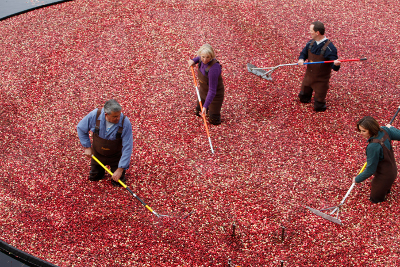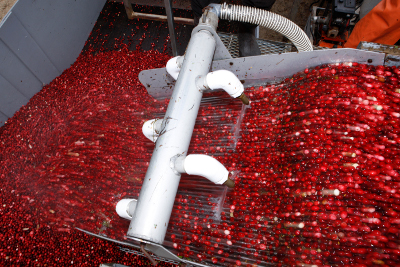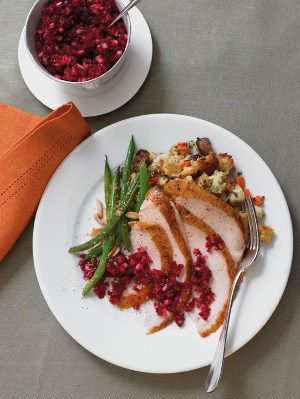What’s Up With That Food: Cranberries
Paste uncovers the background of foods you've always wondered about
Photos courtesy of Ocean Spray Food FeaturesThey grow in bogs. They’re mouth-puckeringly tart. They’re strung with popcorn on Christmas trees for old-timey garlands. Forget Santa—the arrival of cranberries is the quintessential sign that the holiday season is here.
Type of food: Berries
Name: Vaccinium macrocarpon (United States). They’re related to blueberries, huckleberries and bilberries. The name comes from the word “craneberry,” designated by the early settlers from Europe in North America who likened the berry growing on its vine to a crane.
Origins: Cranberries are native to North America and were consumed by Native Americans before the European settlers arrived. In New Jersey, there’s evidence that in the 1830s and 40s, commercial cranberry cultivation began. Sailors would eat them for their vitamin C, to protect themselves from scurvy.
There are a lot of stories about the origins of cranberry sauce. You can thank another New Jersey resident, Elizabeth Lee of New Egypt, for pioneering cranberry sauce: she cooked it up, calling it “Bog Sweet Cranberry Sauce.” It took a bit to catch on, but eventually it did. Marcus Urann, a lawyer who left his career to buy a cranberry bog, however, was the first to think to can (and juice) cranberries in 1912, a move that revolutionized the way cranberries were grown, harvested and marketed. And Elizabeth Lee? Well, she went on to play a part in the development of what would become Ocean Spray, along with Marcus Urann and John C. Makepeace, another competitive grower.
There’s some hearsay that the Native Americans would combine cranberries with maple syrup or honey, but it’s hard to completely substantiate that. “I am a little suspicious of Native American use of honey or maple syrup in the kinds of culinary applications we are familiar with—and suspect that cranberry use probably occurred in stewy mixtures and that both Native Americans and European settlers alike did cook them on open fires (there being no alternative),” says food historian Sandy Oliver. And Kathleen Wall, food historian for Plimoth Plantation, a living history destination in Plymouth, Massachusetts, maintains that in the colonial period there would not have been much honey or maple syrup available.
Why/how did we start eating it: Wisconsin, Massachusetts and New Jersey are top producers for cranberries in the United States. Massachusetts, however, is home to both the first cranberry harvest (1816) and Ocean Spray, the country’s largest and most well-known company, dating to 1930. It also happens to be a grower-owned cooperative with more than 700 grower families across North America.

Cranberries grow in the marshy, acidic soil of bogs on low spreading vines, and the berries have air pockets inside them, which allow them to float in water. A common misconception is that cranberries grown in water. “They are harvested by flooding the bogs, knocking the berries off the vines as they try to rise to the surface and then corralling the berries into conveyors to load them onto trucks,” explains Richard Van Vranken, agricultural agent and professor at Rutgers University Atlantic County Extension Department, in Mays Landing, New Jersey.
According to Ocean Spray, these wet harvested cranberries get turned into various products. The fresh cranberries you find in the stores? They’re dry harvested with a mechanical lawnmower-like picker that combs the berries off the vines and places them in a burlap sack. Cool fact: Helicopters are sometimes deployed to transport those sacks, so heavy trucks don’t destroy the vines.

Ocean Spray sources from the aforementioned states, plus Washington (where the berries are darker because the growing season is longer), Oregon, British Columbia and Quebec and, from March to May, Chile. Americans consume 400,000,000 pounds of cranberries each year, 20 percent of that during Thanksgiving week, says Ocean Spray.
How they’re used: Cranberries were first processed for the masses as the famous molded jelly that you can buy in cans around Thanksgiving. There’s a weird sort of delight to opening up a can of cranberry sauce and sliding it out, in one solid jiggly cylinder, then slicing it up using the imprinted grooves from the can as a guide. You can please those who’d rather have the real deal by purchasing canned whole cranberry sauce, or making your own with fresh cranberries. It’s super easy, endlessly variable—think of accompanying fall flavors and ingredients, from ginger and cinnamon to apples and pears to orange and clove and so forth. Cranberries are high in pectin, which is why once they’re cooked, cooled, and unmolded they hold their shape.
Fresh cranberries, which are quite tart and low in sugar, add bit of a tangy twist to an apple pie and to homemade chutneys. They can be used whole, unpeeled, right in recipes, which makes them a snap to incorporate. Diane Morgan, James Beard Award-winning cookbook author, puts fresh ones to good use in a salsa in The New Thanksgiving Table Cookbook. She sends them through the food processor until they are coarsely chopped, and combines with them with celery, onion and jalapeno and the rest of the ingredients.
Jake Klein of Jake’s Handcrafted in Brooklyn—a sausage shop with cocktails and sides—puts together an “Heirloom Cranberry Cosmo” using heirloom cranberries (which he turns into a simple syrup) with vodka, Cointreau and lime juice. (The cranberries he uses can trace their lineage to the Howes variety, in 1860.)
Cranberries, as the ruby-red harbingers of the holiday season, find their way into all kinds of beverages these days. Owl’s Brew, a company that puts together double-strength teas crafted for cocktails, has designed a special Mulling Blend for the holidays, which brings together cranberry juice, apple cider, dried cranberries and seasonal spices (think bourbon, rum, etc., as pairings). Amy Yakuboff from Owl’s Brew recommends at 2-to-1 ratio of brew to booze. And “cosmic cranberry” is one of many varieties from GT’s Kombucha (among other brands), too.
However you may enjoy these cranberries, when it’s their season, buy extra and freeze them. I stick the bag right into the freezer and pull them out as needed throughout the winter, often adding them frozen right to smoothies, instead of ice. They also work well in your summer barbecue sauces. Nicole Cormier, RD, of Delicious Living Nutrition puts them in energy balls, buckwheat pancakes, grain bowls, and into parfaits with Greek yogurt, among other uses. Her cold-pressed juice company, the Local Juice, offers a variety called Harvest, with carrots, cranberries, orange, lemons and apples.

Diane Morgan’s cranberry salsa from The New Thanksgiving Table Cookbook. Photo by Leigh Beisch.
How they’re purchased: Those ubiquitous cans at Thanksgiving time of jellied cranberry sauce are likely the first encounter most Americans have had with the fruit, but bagged berries begin to show up on grocery shelves and, if you’re lucky, farmers markets in mid to late to October and generally are available through December.
And dried cranberries, which Ocean Spray sweetens and started selling as Craisins in 1993, are available all year long and in various permutations, including infused with blueberry, pomegranate and cherry juices and covered in yogurt.
Sensory experience: Fresh cranberries should have a bit of a snap when you bite into them and they are tart, tart, tart when eaten raw. Dried cranberries, because of their added sugar, balance sweet and tart flavors.
Nutrition and other benefits: Cranberries are often called superfoods due to their intense antioxidant activity and nutrient content. They’re widely known for their ability to help with urinary tract and kidney infections; they’re natural diuretics. Stacey Isaacs, a chef and licensed acupuncturist with a background in Oriental Medicine, says “drinking unsweetened organic cranberry juice (without any additives) is a great way to combat urinary issues; many glasses of water should also be included during a cranberry juice regimen.”
Their health benefits go beyond home remedies for UTIs. “They are a natural bacteria fighter; they help fight tooth decay, ulcers and stomach cancer,” she says. Cavities? Calgary-based dentist Greg Cumberford, DDS, says recent research shows that cranberries inhibit the growth of the bacteria that causes cavities. “It might not hurt to load up a little bit cranberries at Thanksgiving time, or have a handful of them every day or two,” he says. Cranberry juice also works—provided it doesn’t have added sugar.
(Cranberries in toothpaste seems to be the next logical step, right?)
Trivia: Not sure if your fresh cranberries are still good? According to cranberry harvesting practices, good cranberries bounce. The bad ones don’t. In fact, the sorting machines that processors use are designed to take advantage of this.
Carrie Havranek is a recovering music critic and part-time baker who writes about food, farmers’ markets, chefs and restaurants—and sometimes travel—from her home in Easton, Pennsylvania. You may have seen her work elsewhere in Edible Philly, the Kitchn, or Frommer’s.